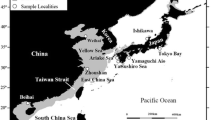Abstract:
The amplified fragment length polymorphism (AFLP) technique was used to assess genetic variation across the genera of 2 Morone and 3 Thunnus species. The AFLP profiles from 23 primers revealed higher levels of polymorphism in each of 3 Thunnus species than in either of the 2 Morone species. However, extensive variation (20 of 23 primers) was observed between the 2 Morone species, but much less variation was observed among the 3 Thunnus species. In addition, comparisons of banding patterns indicated that albacore is divergent from both Atlantic northern bluefin tuna and yellowfin tuna. This result is consistent with the findings of several previous studies employing either allozymes or mitochondrial DNA. Overall, these results demonstrate that AFLP is a useful technique for the assessment of both intraspecies and interspecies variation of fish. Furthermore, the species-specific patterns produced by AFLP can be used for the identification of closely related species.
Similar content being viewed by others
Author information
Authors and Affiliations
Rights and permissions
About this article
Cite this article
Han, K., Ely, B. Use of AFLP Analyses to Assess Genetic Variation in Morone and Thunnus Species. Mar. Biotechnol. 4, 141–145 (2002). https://doi.org/10.1007/s10126-001-0080-8
Issue Date:
DOI: https://doi.org/10.1007/s10126-001-0080-8




